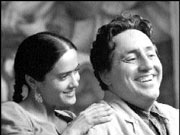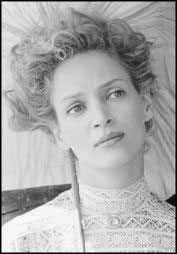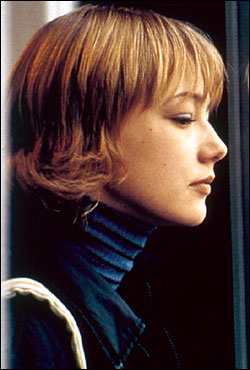FRIDA
directed by Julie Taymor
opens Nov. 1 at Meridian and Metro
WHEN DOES THE FIRST “uh-oh” come in watching Frida, the life of Mexico’s painter-icon who made art out of her suffering (and, some might say, suffering into an art form)? A little after the opening, in which 47-year-old Frida Kahlo (Salma Hayek), pain-wracked and dying, is carried in her four-poster bed to the first-ever show of her paintings in Mexico.
Director Julie Taymor (Titus) moves from this first close look at Frida in her signature Tehuana costume to 14-year-old Frida, knock-kneed and middy-bloused, scampering off with schoolmates for a peek at the infamous muralist Diego Rivera (Alfred Molina). The 36-year-old Hayek plays bratty Frida here, too. Uh-oh.
Kid stuff is tough to ask of any actress, and since Kahlo reappears only a few scenes later, at 18, taking the trolley ride that changed—and nearly ended—her life, continuity seems to have won out over kindness. (The accident crushed Kahlo’s spine, fractured her pelvis and one foot, and impaled her on a railing.) What about Hayek’s performance? Impassioned, not wholly successful, but certainly nothing to be mortified about. That would be Ashley Judd turning the thoughtful, principled Tina Modotti into the vamp of Savannah.
Oddly, in a female-centric drama, men fare better. Molina as a commanding and willful Rivera, and Roger Rees, as Frida’s compassionate, well-born German-Jewish father, linger longest.
As the film’s co-producer, whose seven-year-long tenacity got the picture made, Hayek deserves enormous credit along with Taymor for real locales, impeccable art direction and camera work, and painstaking costuming—and for routing the Fridas of J.Lo and Madonna. However, if, as reported, the script is Edward Norton’s uncredited rewrite of scripts by four predecessors, “uh-oh” again. (Norton, who plays Nelson Rockefeller, charisma-free, is Hayek’s lover.) The script plods, like a tiresome diary. It never pulls up for an overview, never makes clear the political undercurrents that splintered Frida’s Marxist artist-friends. When Leon Trotsky finally appears with windy speeches about the pain and failures of his life (and for the briefest fling with Frida), the underprepared audience may simply go goggle-eyed.
CRUCIALLY, FRIDA has no tragic trajectory. The push-pull between Kahlo and her loving, monumentally unfaithful husband becomes, “Can’t live with him, can’t live without him.” (Among the dialogue’s high points: Kahlo calling Rivera “a big Mexican pi�, with enough candy for everyone.”) Famed for her stage production of The Lion King, Taymor does inject brief spurts of invention that pull the film’s head up from its plodding trip down the rutted biopic trail. There’s Frida’s jittery, spook-filled hospital nightmare using Day of the Dead skeletons (a creation of the great Quay Brothers), and a hilarious King Kong sequence, as Rivera takes Manhattan, that is pure Taymor. Yet there’s a vast difference between Taymor’s need for visual shock and Kahlo’s need to paint as honestly as she lived.
It’s a good bet that neither Taymor nor Hayek but Miramax—the biggest “uh-oh” of all—had the final say on how Kahlo looks in the movie. An early production shot in the glossy “making of the film” book proves that Hayek intended to play Frida, of the famous unibrow and the delicately delineated moustache, as a woman who’d never shave her underarms. Well, yeah.
No more. Zip the moustache, depilate the rest, and get on with it.
Hair or no hair may seem niggling, yet it’s at the heart of the picture’s underlying timidity. What’s being marketed is not the story of a unique, infinitely complex woman whose work was the mainstay of her life, but something sanitized and more salable: She loved, she suffered, she painted . . . a little.
Good luck to the audience that comes wanting to understand what made Frida Kahlo the lasting image of the past half-century, its Marxist Mona Lisa. That woman is still to be discovered on film.









